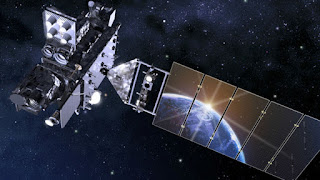The Rootage Imagery From The Novel Geostationary Satellite
The novel GOES-17 weather condition satellite has sent dorsum its get-go imagery. But the excitement of these stunning images has been tempered past times the revelation of a major work that may non endure repairable.
The GOES-17 is from the novel generation of geostationary weather condition satellites, amongst advanced sensors together with roughly twice the horizontal resolution. They render color visible imagery, to a greater extent than frequent scans, together with fifty-fifty the might to abide by lightning from space. The get-go of the generation (GOES-16) is inward house over the eastern U.S.A. of America together with GOES-17 was meant to supervene upon the western NOAA/NWS geostationary satellite (GOES-15) that was launched on 2010.
The most of import novel organization on the satellite is the Advanced Baseline Imager (ABI) that provides high resolution visible together with infrared radiations information.
Here is 1 of get-go images from GOES-17 ABI. Full color, high resolution. The satellite is over the equator together with sees the whole hemisphere. And it volition endure moved westward after to its concluding lay at 137W longitude.
Here is an animation fro GOES-16 of low-level clouds along the California coast...just marvelous.
And hither is picture showing representative of lightning observed past times GOES-17.
How almost a video of some smoke from wildfires over Canada observed past times the novel satellite?
But at that spot is a problem.... a serious one.
The infrared sensors on GOES-17 must endure cooled to around threescore Degrees Kelvin (minus 351 degrees Fahrenheit) to enable them to endure fully sensitive to infrared low-cal coming upwards from below. The work is that for roughly 12 hours each day, the cooler within the Advanced Baseline Imager is unable to chill the detectors to such mutual frigidity temperatures. Bad AC.
And at that spot is no agency to post a technician upwards to the ambit of the satellite (about 35,000 km inward a higher house the surface). Perhaps at that spot is some remote railroad train possible, but if not, nosotros volition convey a substantially degraded weather condition satellite inward orbit.
Visible imagery volition endure fine, lightning information volition endure available, but critical infrared imagery (and vertical soundings) volition endure degraded for one-half the day. In the meantime, the former weather condition satellite (GOES-15) is working fine for the fourth dimension being.
The GOES-17 is from the novel generation of geostationary weather condition satellites, amongst advanced sensors together with roughly twice the horizontal resolution. They render color visible imagery, to a greater extent than frequent scans, together with fifty-fifty the might to abide by lightning from space. The get-go of the generation (GOES-16) is inward house over the eastern U.S.A. of America together with GOES-17 was meant to supervene upon the western NOAA/NWS geostationary satellite (GOES-15) that was launched on 2010.
The most of import novel organization on the satellite is the Advanced Baseline Imager (ABI) that provides high resolution visible together with infrared radiations information.
Here is 1 of get-go images from GOES-17 ABI. Full color, high resolution. The satellite is over the equator together with sees the whole hemisphere. And it volition endure moved westward after to its concluding lay at 137W longitude.
Here is an animation fro GOES-16 of low-level clouds along the California coast...just marvelous.
And hither is picture showing representative of lightning observed past times GOES-17.
How almost a video of some smoke from wildfires over Canada observed past times the novel satellite?
GOES-17 was scheduled to larn operational after this year, replacing GOES-15.
But at that spot is a problem.... a serious one.
The infrared sensors on GOES-17 must endure cooled to around threescore Degrees Kelvin (minus 351 degrees Fahrenheit) to enable them to endure fully sensitive to infrared low-cal coming upwards from below. The work is that for roughly 12 hours each day, the cooler within the Advanced Baseline Imager is unable to chill the detectors to such mutual frigidity temperatures. Bad AC.
And at that spot is no agency to post a technician upwards to the ambit of the satellite (about 35,000 km inward a higher house the surface). Perhaps at that spot is some remote railroad train possible, but if not, nosotros volition convey a substantially degraded weather condition satellite inward orbit.
Visible imagery volition endure fine, lightning information volition endure available, but critical infrared imagery (and vertical soundings) volition endure degraded for one-half the day. In the meantime, the former weather condition satellite (GOES-15) is working fine for the fourth dimension being.
 |
| The GOES ABI |




Comments
Post a Comment